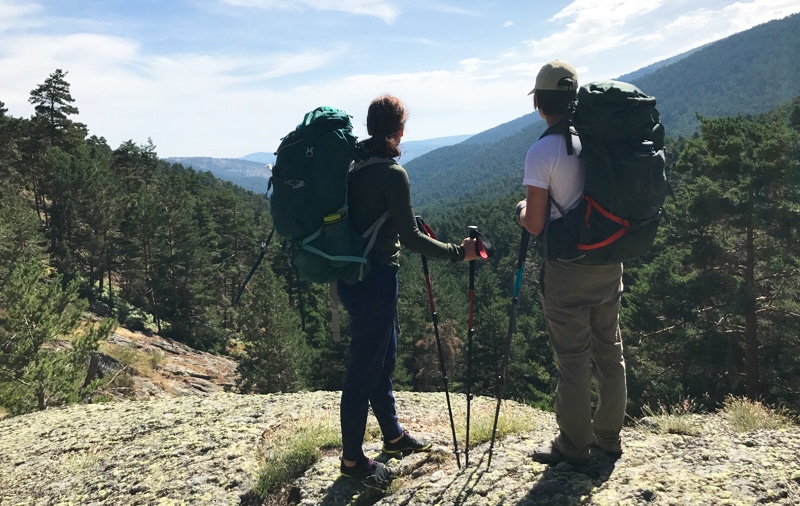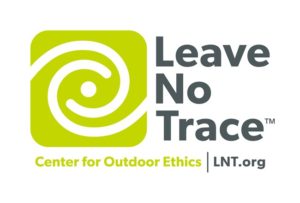Leave No Trace 7 Principles

1. Plan Ahead and Prepare
Adequate trip planning and preparation helps backcountry travelers accomplish trip goals safely and enjoyably, while simultaneously minimizing damage to the land. Poor planning often results in miserable campers and damage to natural and cultural resources.
-Know the regulations and special concerns for the area you’ll visit. Identify the skill and ability of trip participants and select destinations that match your goals, skills, and abilities.
-Prepare for extreme weather, hazards, and emergencies. Choose equipment and clothing for comfort, safety, and Leave No Trace qualities
-Schedule your trip to avoid times of high use and visit in small groups when possible. Consider splitting larger groups into smaller groups.
-Repackage food to minimize waste. Most food should be removed from its commercial packing and placed in sealable bags before packing your backpacks.
-Use a map and compass to eliminate the use of marking paint, rock cairns or flagging. Gain knowledge of the area you plan to visit from land managers, maps, and literature.
Why Is Trip Planning Important?
-It helps ensure the safety of groups and individuals.
-It prepares you to Leave No Trace and minimizes resource damage.
-It contributes to accomplishing trip goals safely and enjoyably.
-It increases self-confidence and opportunities for learning more about nature.
2. Travel and Camp on Durable Surfaces
The goal of travel in the outdoors is to move through natural areas while avoiding damage to the land or waterways. Understanding how travel causes impacts is necessary to accomplish this goal. Travel damage occurs when surface vegetation or communities of organisms are trampled beyond recovery. The resulting barren area leads to soil erosion and the development of undesirable trails. Backcountry travel may involve travel over both trails and off-trail areas.
-Durable surfaces include established trails and campsites, rock, gravel, dry grasses or snow/ice.
-Encourage travelers to stay within the width of the trail and not short cut trail switchbacks (trail zigzags that climb hill sides). Travelers should provide space for other hikers if taking breaks along the trail.
-Protect riparian areas by camping at least 200 feet from lakes and streams. Camping away from the water’s edge also allows access routes for wild life. Be sure to obey regulations related to campsite selection
-Good campsites are found, not made. Altering a site is not necessary. -In popular areas: Concentrate use on existing trails and campsites. Walk single file in the middle of the trail, even when wet or muddy. Keep campsites small. On high-impact sites, tents, traffic routes, and kitchen areas should be concentrated on already impacted areas.
-In pristine areas: Disperse use to prevent the creation of campsites and trails. Minimize the number of times any part of the site is trampled. Covering scuffed areas with native materials (such as pine needles), brushing out footprints, and raking matted grassy areas with a stick will help the site recover and make it less obvious as a campsite.
3. Dispose of Waste Properly
We encourage outdoor enthusiasts to consider the impacts that they leave behind, which will undoubtedly affect other people, water and wildlife.
-Pack it in, pack it out. Inspect your campsite and rest areas for trash or spilled foods. Pack out all trash, leftover food and litter.
-Deposit solid human waste in cat holes dug 6 to 8 inches deep, at least 200 feet from water, camp and trails. Select an inconspicuous site untraveled by people. Examples of cat hole sites include thick undergrowth, near downed timber, or on gentle hillsides. Cover and disguise the cat hole when finished. If camping in the area for more than one night, or if camping with a large group, cat hole sites should be widely dispersed.
-Pack out toilet paper and hygiene products. Do not bury them because they don’t decompose readily and animals may dig them up.
-Urinating on rocks, pine needles, and gravel is less likely to attract wildlife. Diluting urine with water from a water bottle can help minimize negative effects.
-To wash yourself or your dishes, carry water 200 feet away from streams or lakes and use small amounts of biodegradable soap. Scatter strained dishwater.
“Pack it in, Pack it out” is a popular mantra to seasoned wildland visitors. Any user of recreation lands has a responsibility to clean up before he or she leaves. Inspect your campsite and rest areas for trash or spilled foods. Pack out all trash and garbage.
4. Leave What You Find
Allow others a sense of discovery by leaving rocks, plants, archaeological artifacts and other objects of interest as you find them.
-Preserve the past: examine, but do not touch cultural or historic structures and artifacts. Natural objects of beauty or interest such as antlers, petrified wood, or colored rocks add to the mood of the backcountry and should be left so others can experience a sense of discovery.
-Leave rocks, plants and other natural objects as you find them. Avoid hammering nails into trees for hanging things, hacking at them with hatchets and saws, or tying tent guy lines to trunks, thus girdling the tree.
-Avoid introducing or transporting non-native species. Careful not to deplete the surviving vegetation or disturb plants that are rare or are slow to reproduce.
-Do not dig trenches for tents or construct lean-tos, tables, chairs, or other rudimentary improvements. If you clear an area of surface rocks, twigs or pine cones, replace these items before leaving.
5. Minimize Campfire Impacts
The development of lightweight efficient camp stoves has encouraged a shift away from the traditional fire for cooking. Stoves have become essential equipment for minimum-impact camping. They are fast, flexible and eliminate firewood availability as a concern in campsite selection. Stoves operate in almost any weather condition—and they Leave No Trace.
-Campfires can cause lasting impacts to the backcountry. Use a lightweight stove for cooking and enjoy a candle lantern for light. Stoves have be come essential equipment for minimum-impact camping. They are fast, flexible, and eliminate firewood availability as a concern in campsite selection.
-Where fires are permitted, use established fire rings, fire pans, or mound fires. Choose not to have a fire in areas where there is little wood at higher elevations, in heavily used areas, or in desert settings.
-Keep fires small. Only use sticks from the ground that can be broken by hand. Gather wood over a wide area away from camp and scatter unused wood to keep the area as natural looking as possible.
-Burn all wood and coals to ash, put out campfires completely, then scatter cool ashes. Pack out any campfire litter.
Safety
-Provide adequate supervision for young people when using stoves or fires.
-Follow all product and safety labels for stoves.
-Use approved containers for fuel.
-Never leave a fire unattended.
-Keep wood and other fuel sources away from fire.
-Thoroughly extinguish all fires.
6. Respect Wildlife
Learn about wildlife through quiet observation. Do not disturb wildlife or plants just for a “better look.” Observe wildlife from a distance so they are not scared or forced to flee. Large groups often cause more damage to the environment and can disturb wildlife so keep your group small. If you have a larger group, divide into smaller groups if possible to minimize your impacts.
-Observe wildlife from a distance. Do not follow or approach them. It is stressful to the animal, and it is possible that the animal may harbor rabies or other diseases. Sick or wounded animals can bite, peck or scratch and send you to the hospital. Young animals removed or touched by well-meaning people may cause the animals parents to abandon them.
-Never feed animals. Feeding wildlife damages their health, alters natural behaviors, and exposes them to predators and other dangers.
-Protect wildlife and your food by storing rations and trash securely. Camps should be located 200 feet or more from existing water sources. This will minimize disturbance to wildlife and ensure that animals have access to their precious drinking water.
-Control pets at all times, or leave them at home. Dogs running free can be unwelcome, frightening people or leaving behind unwanted “presents”.
-Avoid wildlife during sensitive times: mating, nesting, raising young, or winter.
7. Be Considerate of Other Visitors
One of the most important components of outdoor ethics is to maintain courtesy toward other visitors. It helps everyone enjoy their outdoor experience. Many people come to the outdoors to listen to nature. Excessive noise, uncontrolled pets and damaged surroundings take away from the natural appeal of the outdoors.
-Respect other visitors and protect the quality of their experience. Keep the noise level down while traveling and if you bring a radio, tapes or CDs, use headphones so you will not disturb others.
-Be courteous. Yield to other users on the trail. Step to the downhill side of the trail when encountering pack stock.
-Take breaks and camp away from trails and other visitors. Take rest breaks on durable surfaces well off the designated trail. When selecting a campsite, choose a site where rocks or trees will screen it from others view. Keep noise down in camp so not to disturb other campers or those passing by on the trail.

The Leave No Trace Center for Outdoor Ethics protects the outdoors by teaching and inspiring people to enjoy it responsibly. The Center accomplishes this mission by delivering cutting-edge education and research to millions of people every year.
Always practice Leave No Trace ethics on your hikes and adventures. Be aware of local regulations and don’t damage these amazing places.
Enjoy your world. Leave No Trace.
DREAMPEAKS: HIKING IN MADRID. ADVENTURE TOURS IN MADRID. OUTDOOR ACTIVITIES IN SPAIN.
Text by Gabriel Blanco (Mountain Guide).
